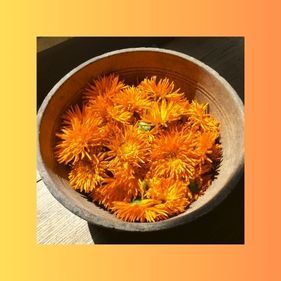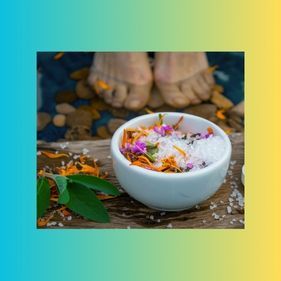The Remarkable Benefits of Calendula in Herbal Healing
Welcome to the intriguing world of herbal medicine, where ancient wisdom meets modern remedies. 🌿💚
[**This post is part of a spin-off from a post on The Medicinal Garden Kit , your gateway to creating your own "backyard pharmacy" and healing oasis at home. 🌱
The next post is on the healing powers of the herb Feverfew.
For now - sit back, relax, and embark on a journey of discovery with us.✨]
🌼 Harnessing the Healing Power of Calendula: Exploring its Role in Herbal Medicine 🌼
Step into a world brimming with the vibrant hues of nature's healing touch - Calendula.
This remarkable herb, also known as marigold, has been revered for centuries for its medicinal properties and versatile applications in herbal medicine. From ancient civilizations to modern herbal practitioners, Calendula has captivated minds and hearts with its profound healing abilities.
Join us as we delve into the captivating realm of Calendula ... uncovering its rich history, therapeutic benefits, and how it continues to play a prominent role in herbal healing today.
Let's embark on a journey of discovery and unlock the secrets of this remarkable herb that nature gave us. 🌱✨
What is Calendula?
Calendula, also known as Calendula officinalis, is a vibrant and beautiful herb that holds a special place in the world of herbal medicine. With its bright yellow or orange flowers and distinctive aroma, Calendula is a sight to behold.

It belongs to the Asteraceae family and is native to the Mediterranean region, although it is now widely cultivated around the world.
Why It's a Great Find
Across various cultures and traditions, Calendula has been prized for its medicinal properties ... The flowers contain a rich array of chemicals, including flavonoids, essential oils, triterpenoids, carotenoids, and saponins, which contribute to its therapeutic effects.
Your Need-to-Know
In herbal medicine, Calendula has been used for centuries due to its anti-inflammatory, antimicrobial, and immune-stimulating properties.
It is commonly used topically to help heal wounds, soothe skin irritations, and reduce inflammation. Calendula-infused oils and creams are often applied to treat cuts, burns, bruises, eczema, and acne.

Internally, Calendula can be taken in the form of teas, tinctures, or capsules to promote digestive health, alleviate menstrual cramps, and support liver function.
It is also known for its mild diuretic properties and may be helpful in relieving urinary tract infections.
Precautions to Consider
- While Calendula is generally considered safe, it's important to note potential side effects and interactions. Some individuals may experience allergic reactions, so it's advisable to perform a patch test before using it topically.
- As with any herbal remedy, it's always wise to consult with a healthcare professional, especially if you have any underlying medical conditions or are taking medications.
- Regarding its safety for pregnant or breastfeeding women, there is limited data available. It is generally recommended to avoid using Calendula internally during pregnancy and breastfeeding, just to err on the side of caution.
To Grow or Not to Grow?
For those interested in growing Calendula, it is a relatively easy herb to cultivate. It thrives in full sun and well-drained soil.
The seeds can be sown directly in the garden or started indoors and transplanted. Regular watering and deadheading of spent flowers will encourage continuous blooming.
To harvest Calendula: pick the flowers when they are fully open and dry them in a well-ventilated area away from direct sunlight. Once dried, store them in an airtight container in a cool, dark place to maintain their potency.
Overall, Calendula is a versatile herb that offers numerous benefits in herbal medicine. Whether used topically or internally, it can provide natural relief for a range of conditions.

**However, it's always important to consult with a qualified herbalist or healthcare professional before incorporating any new herbs or supplements into your routine.
FAQs
Q: Is Calendula safe to use topically on the skin?
A: Yes, Calendula is generally safe to use topically on the skin ... Its soothing properties make it a popular choice for treating various skin conditions such as cuts, burns, bruises, eczema, and acne.
However, it's important to perform a patch test before applying Calendula to a larger area, as some individuals may have an allergic reaction. If you experience any adverse effects, discontinue use and consult with a healthcare professional.
Q: Can Calendula be taken internally as an herbal remedy?
A: Yes, Calendula can be taken internally in the form of teas, tinctures, or capsules --- It is commonly used to promote digestive health, alleviate menstrual cramps, support liver function, and relieve urinary tract infections.
However, it's always recommended to consult with a qualified herbalist or healthcare professional before incorporating Calendula into your internal regimen, especially if you have any underlying medical conditions or are taking medications.
Q: Can pregnant or breastfeeding women use Calendula safely?
A: While Calendula is generally considered safe, there is limited data available on its specific safety during pregnancy and breastfeeding.
As a precaution, it is advisable for pregnant or breastfeeding women to avoid using Calendula internally.
However, topical use of Calendula on the skin is typically well-tolerated. It's always best to consult with a healthcare professional to ensure the safety of any herbal remedies during pregnancy or while breastfeeding.
The Takeaway
Summing up, Calendula stands as a shining example of nature's incredible healing powers. From its vibrant petals to its soothing properties, this herb has played a significant role in herbal medicine for centuries.
Whether it's treating skin conditions, promoting digestive health, or supporting overall well-being, Calendula continues to captivate herbal enthusiasts and practitioners alike.
Your Next Move
As we embrace the rich history and therapeutic benefits of this remarkable herb, let us remember to approach its usage with care, seeking guidance from experts in the field.
So, let us celebrate the enduring legacy of Calendula and allow its profound healing qualities to blossom in our lives.
Let nature's delicate touch remind us of the miracles that lie within the petals of this extraordinary herb.
If you want to explore even more about these and other treasures in herbal medicine🌿 ...
Thank you for stopping by and reading along with us ...
Sources:
- National Center for Complementary and Integrative Health - Calendula: https://www.nccih.nih.gov/health/calendula
- Herbal Medicine: Biomolecular and Clinical Aspects - Chapter 13: Calendula officinalis L. and Wound Healing: https://www.ncbi.nlm.nih.gov/books/NBK92765/
- American Herbalists Guild - Calendula officinalis: https://www.americanherbalistsguild.com/herb/calendula-officinalis
Disclaimer.
When you purchase through links on our site, we may earn an affiliate commission (that's how we stay in business). FirstFewFinds may use affiliate links to products and services on retailer sites for which we can receive compensation if you click on those links or make purchases through them. We hope you find the list of our first few finds useful and helpful. Each product on our list has been carefully chosen by our writers and all opinions are our own. Check your choices and enjoy finding exactly what you need!








